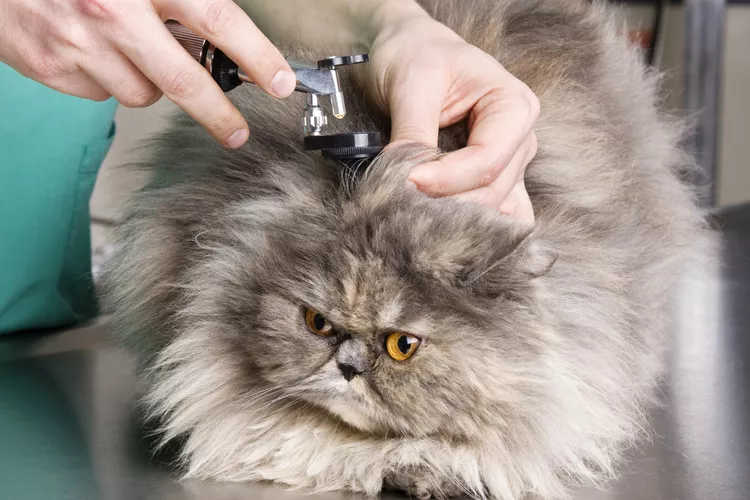Ear Infections in Cats

Ear infections are common among cats, and they can be tricky to treat because they have numerous causes. Cats' ears can be invaded by various parasites, irritated by allergies, or plagued by polyps. A veterinary diagnosis is crucial in determining a targeted treatment plan. Left untreated, ear infections can lead to hearing loss or more serious systemic infections. If you notice your cat scratching an ear or tilting its head, schedule a vet visit to investigate.
What Is an Ear Infection?
An ear infection is a bacterial or fungal overgrowth in a cat's ear canal. While there are numerous causes of infection, the root problem is an imbalance in the ear's natural flora. Excess moisture may accumulate due to structural abnormalities or foreign objects; while allergies or ear mites can cause irritation and the build-up of waxy debris. Whatever the trigger, the result is an infection that requires treatment to eliminate the specific cause and restore a healthy balance in the ear.
Symptoms of Ear Infection in Cats
Regardless of the cause of the ear infection, the signs of an ear problem usually look similar. If you notice these issues, it's time to visit the vet:
Head shaking, tilting, and scratching are indicative of an ear infection, which may be present in one or both ears. The infection causes extreme itching and irritation. Unpleasant smells and discharge are more common once the infection has been active for over a week, and scabs from scratching will eventually become obvious in the absence of treatment. If ear mites are present, then a dark, waxy build-up will be apparent. Rarely do any of the other observable symptoms point to the cause of infection, which must be determined by a veterinarian.
Ear Mites
Ear mites are responsible for a majority of the ear infections seen in cats. These parasites will be one of the first things your veterinarian checks for if your cat has an ear infection. The irritating presence of these tiny bugs inflames a cat's ears and causes excess wax production, prompting the cat to scratch and create open sores. The resulting ear environment is susceptible to bacterial overgrowth and infection.
Ear mites cause a characteristic dark brown to black discharge in the ears that looks a bit like coffee grounds. The presence of this discharge is often the first indication that your cat has ear mites. Your veterinarian may also examine the debris from your cat's ears under a microscope to find evidence of ear mites. Once identified, mites can be treated with miticide ear drops, or a systemic pest control medication will be prescribed to treat the problem. If a secondary bacterial infection has developed, then antibiotics may be prescribed as well.
Causes
External or environmental factors cause most ear infections in cats, triggering inflammation and throwing off the balance of the ear so that bacteria or fungi can thrive. In some cases, small polyps may grow in a cat's ear which also set the stage for infection due to blockage and moisture accumulation. The most common causes of ear infections in cats are:
- Ear mites
- Allergies (food or environmental)
- A foreign body lodged in the ear
- Polyps
Diagnosing Ear Infections in Cats
The diagnosis starts with an examination of the ears. Your veterinarian will perform an examination of your cat's ears with an otoscope, which illuminates and magnifies the inside of the ear canal. Your vet will look for signs such as redness and inflammation, discharge, polyps, foreign bodies, or any other abnormalities.
Depending on the severity of the infection, sedation may be necessary to thoroughly flush the ear canal and conduct a thorough examination.
Ear cytology is sometimes necessary if a cause can't readily be identified. This involves swabbing the inside of your cat's ear and then using a microscope to look for abnormal cells, bacteria, or yeast. The results of this test will help your veterinarian determine which antibiotics or other medications are best used in your cat's ears.
An ear culture may be performed, particularly if ear cytology indicates a bacterial infection that is not responding well to antibiotic treatment. An ear culture will tell your veterinarian what type of bacteria is present in your cat's ears and test specific antibiotics to determine if they are effective in killing that bacteria.
Treatment
Since there are many different causes of feline ear infections, there is no single treatment that will work for every situation. In some instances, antibiotics or antifungals may be warranted. In others, simply cleaning and flushing the ear canal may be sufficient. Ear mites require a specific pesticide, while polyps may need to be surgically removed. Dietary changes to eliminate allergenic food items are a longer-term "test" treatment to see if the cat's infection clears up completely, and you will probably need to treat the ears topically during this time to ease inflammation and allow healing of the tissues.
Prognosis for Cats with Ear Infections
Cats usually respond well to treatment for ear infections and recover within a few weeks. Ear mites may require multiple treatments of miticide to fully eradicate the problem, but persistence will pay off. Polyps require more invasive treatment, so the cat's recovery will depend on the severity of the problem and the health of its immune system.
Prevention
While it's not possible to prevent your cat from ever getting an ear infection, you may be able to prevent an infection from becoming serious by being alert to the symptoms. Healthy cat ears are light pink, free of wax and other debris, and don't have an unpleasant odor. A change in the color or smell of its ears may indicate that your cat has an infection brewing. Cats' ears should not be flushed regularly in an attempt to keep them clean; doing so may alter the ears' natural bacterial balance and make them more susceptible to infection.